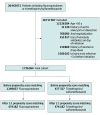Association of Fluoroquinolones With the Risk of Aortic Aneurysm or Aortic Dissection
- PMID: 32897307
- PMCID: PMC7489402
- DOI: 10.1001/jamainternmed.2020.4199
Association of Fluoroquinolones With the Risk of Aortic Aneurysm or Aortic Dissection
Abstract
Importance: Previous observational studies have suggested that fluoroquinolones are associated with aortic aneurysm or dissection, but these studies may be subject to confounding by indication or surveillance bias.
Objective: To assess the association of fluoroquinolones with risk of aortic aneurysm or aortic dissection (AA/AD) while accounting for potential confounding by fluoroquinolone indication and bias owing to differential surveillance.
Design, setting, and participants: In an observational cohort study using a US commercial claims database, 2 pairwise 1:1 propensity score-matched cohorts were identified: patients aged 50 years or older with a diagnosis of pneumonia 3 days or less before initiating treatment with a fluoroquinolone or azithromycin and patients aged 50 years or older with a urinary tract infection (UTI) diagnosis 3 days or less before initiating a fluoroquinolone or combined trimethoprim and sulfamethoxazole. Hazard ratios (HRs) and 95% CIs were estimated controlling for 85 baseline confounders. In a secondary analysis, patients receiving fluoroquinolones were compared with those receiving amoxicillin, both with and without considering baseline aortic imaging, to address differences in detection of AA/AD before antibiotic use. Data on patients within the database from January 1, 2003, through September 30, 2015, were analyzed. Data analysis was conducted from July 23, 2019, to July 6, 2020.
Main outcomes and measures: Hospitalization for AA/AD occurring within 60 days following treatment initiation.
Results: After propensity score matching, patient characteristics were well balanced, with 279 554 patients (mean [SD] age, 63.66 [10.93] years; 149 976 women [53.6%]) in the pneumonia cohort and 948 364 patients (mean [SD] age, 62.06 [10.33] years; 823 667 women [86.9%]) in the UTI cohort. Initiators of fluoroquinolones (n = 139 772 pairs in the pneumonia cohort and n = 474 182 pairs in the UTI cohort) had an increased rate of AA/AD compared with initiators of azithromycin (HR, 2.57; 95% CI, 1.36-4.86; incidence, 0.03% for fluoroquinolones vs 0.01% for azithromycin) but no increased rate compared with initiators of combined trimethoprim and sulfamethoxazole (HR, 0.99; 95% CI, 0.62-1.57; incidence, <0.01% in both UTI groups). Secondary analysis using amoxicillin as a comparator (n = 3 976 162 pairs) produced results consistent with those from earlier studies (HR, 1.54; 95% CI, 1.33-1.79; incidence, <0.01% in both groups). Requiring baseline imaging in this cohort (n = 542 649 pairs) to address surveillance bias attenuated the increased rate (HR, 1.13; 95% CI, 0.96-1.33; incidence, 0.06% for fluoroquinolones vs 0.05% for amoxicillin).
Conclusions and relevance: The findings of this nationwide cohort study of adults with pneumonia or UTI suggest an increased relative rate of AA/AD associated with fluoroquinolones within the pneumonia cohort but not within the UTI cohort. In both cohorts, the absolute rate of AA/AD appeared to be low (<0.1%). The increased relative rate observed in the pneumonia cohort may be due to residual confounding or surveillance bias.
Conflict of interest statement
Figures
Comment in
-
Observational Study Design Challenges-The Case of Fluoroquinolones and Aortic Disease.JAMA Intern Med. 2020 Dec 1;180(12):1605-1606. doi: 10.1001/jamainternmed.2020.4191. JAMA Intern Med. 2020. PMID: 32897290 No abstract available.
-
Fluoroquinolones and Aortic Disease-Reply.JAMA Intern Med. 2021 Jun 1;181(6):881-882. doi: 10.1001/jamainternmed.2020.9220. JAMA Intern Med. 2021. PMID: 33646261 No abstract available.
-
Fluoroquinolones and Aortic Disease.JAMA Intern Med. 2021 Jun 1;181(6):881. doi: 10.1001/jamainternmed.2020.9226. JAMA Intern Med. 2021. PMID: 33646264 No abstract available.
References
-
- Heidelbaugh JJ, Holmstrom H. The perils of prescribing fluoroquinolones. J Fam Pract. 2013;62(4):191-197. - PubMed
Publication types
MeSH terms
Substances
Grants and funding
LinkOut - more resources
Full Text Sources
Medical



